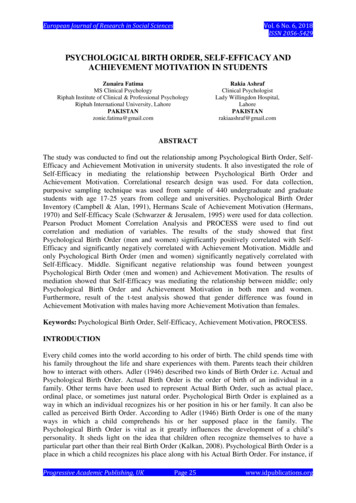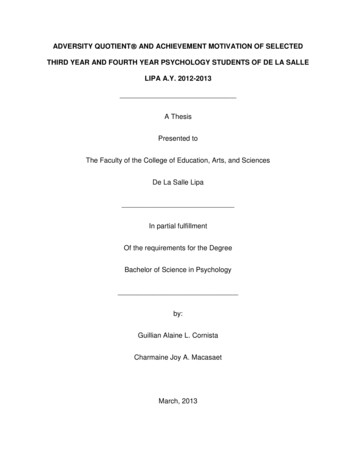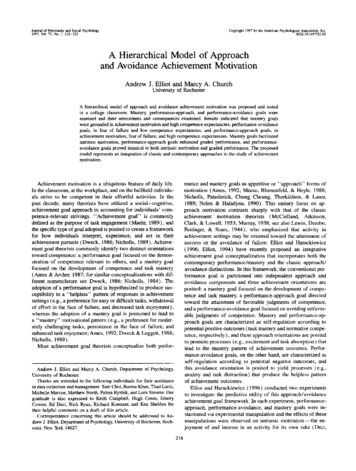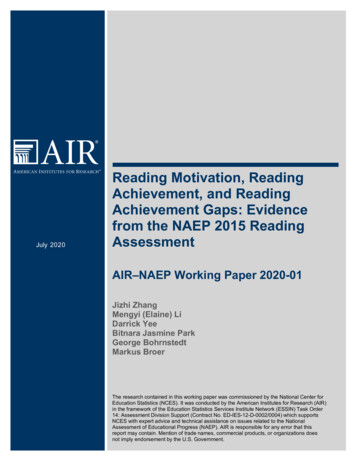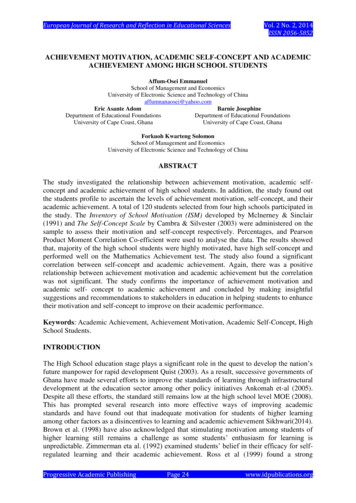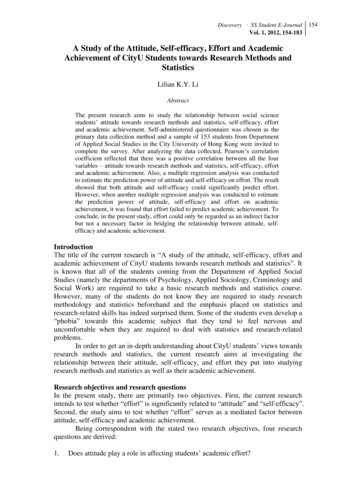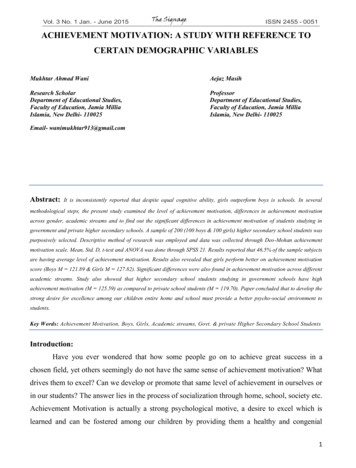
Transcription
Vol. 3 No. 1 Jan. - June 2015The SignageISSN 2455 - 0051ACHIEVEMENT MOTIVATION: A STUDY WITH REFERENCE TOCERTAIN DEMOGRAPHIC VARIABLESMukhtar Ahmad WaniAejaz MasihResearch ScholarDepartment of Educational Studies,Faculty of Education, Jamia MilliaIslamia, New Delhi- 110025ProfessorDepartment of Educational Studies,Faculty of Education, Jamia MilliaIslamia, New Delhi- 110025Email- wanimukhtar913@gmail.comAbstract:It is inconsistently reported that despite equal cognitive ability, girls outperform boys is schools. In severalmethodological steps, the present study examined the level of achievement motivation, differences in achievement motivationacross gender, academic streams and to find out the significant differences in achievement motivation of students studying ingovernment and private higher secondary schools. A sample of 200 (100 boys & 100 girls) higher secondary school students waspurposively selected. Descriptive method of research was employed and data was collected through Deo-Mohan achievementmotivation scale. Mean, Std. D, t-test and ANOVA was done through SPSS 21. Results reported that 46.5% of the sample subjectsare having average level of achievement motivation. Results also revealed that girls perform better on achievement motivationscore (Boys M 121.89 & Girls M 127.82). Significant differences were also found in achievement motivation across differentacademic streams. Study also showed that higher secondary school students studying in government schools have highachievement motivation (M 125.59) as compared to private school students (M 119.70). Paper concluded that to develop thestrong desire for excellence among our children entire home and school must provide a better psycho-social environment tostudents.Key Words: Achievement Motivation, Boys, Girls, Academic streams, Govt. & private Higher Secondary School StudentsIntroduction:Have you ever wondered that how some people go on to achieve great success in achosen field, yet others seemingly do not have the same sense of achievement motivation? Whatdrives them to excel? Can we develop or promote that same level of achievement in ourselves orin our students? The answer lies in the process of socialization through home, school, society etc.Achievement Motivation is actually a strong psychological motive, a desire to excel which islearned and can be fostered among our children by providing them a healthy and congenial1
atmosphere for their development. It is a widely researched topic in both the fields of psychologyand education. Achievement motivation can best be understood by examining the meanings of“achievement” and “motivation” separately. Achievement typically stresses the importance ofaccomplishment and attainment with effort involved (Mandel & Marcus, 1988). Motivationrelates to an individual's reason for engaging in an activity, the degree to which an individualpursues the activity, and the persistence of the individual (Graham & Weiner, 1996).Achievement motive is a concept developed by the social psychologist McClelland to denote thestrong urge felt by an individual or society for achievement in various aspects like education,culture, money, etc. that satisfies the need of self-esteem. The achievement motive is thedeciding factor in attaining success in different fields. An achieving society is characterized bythe history of a strong and persistent achievement motivation. According to Atkinson andFeather (1966), “Achievement motivation is conceived as a talent disposition which ismanifested in overt striving only when the individual perceives performance as instrumental to asense of personal accomplishment.” Individuals high in achievement motivation are at their bestwhen they can maintain a high level of involvement in ensuring the excellence of activities undertheir coordination or control. However, they do relatively less well when required to manageexcessive tasks or to function in highly stressful environments. As it is a learned motive, the roleof school becomes imperative for its development. The socio-psychological & physicalenvironment of the school has its direct influence on the students.Some studies have been conducted previously to study the relationship between schoolenvironment and need-achievement like Chaturvedi (2009) found that there is significantrelationship between school environment and need-achievement of children. SimilarlyNagarathanamma and Rao (2007) designed a study to see the difference between adolescent boysand girls on achievement motivation. They found that there was no significant differencebetween boys and girls with regard to achievement motivation level. Kaushik & Rani (2005) andSingh, V, R (2014) also confirmed the findings that there was no significant gender difference onachievement motivation in students of four educational streams.Significance:It is hoped that this study will provide information for parents, educators and schooladministrators to reflect upon various factors that help students in developing higherachievement goals. In so doing, they can investigate the possibility of introducing those factors2
in their school, which may consequently lead to enhancing students’ need-achievement levels. Inaddition, the fact that this study is conducted on govt. and private schools, it shares quite a lot ofsimilarities and dissimilarity between two. Further in the present competitive world everyaspirant student is feeling the pressure of their secure future rather they should feel insecure interms of career, choice of profession to live a healthy life. Hence studying achievementmotivation at higher secondary level becomes important, because this stage is the base fordifferent competitive examinations and basis for future life development.Objectives:1. To identify the level of achievement motivation among higher secondary school students.2. To find out the significant differences in achievement motivation among highersecondary school students across gender.3. To find out the significant differences in achievement motivation among highersecondary school students across different academic streams.4. To find out the significant differences in achievement motivation among highersecondary school students across the type of school.Hypotheses:1. There is no significant difference in achievement motivation of higher secondary schoolstudents across gender.2. There is no significant difference in achievement motivation of higher secondary schoolstudents having different academic streams.3. There is no significant difference in achievement motivation of higher secondary schoolstudents across the type of school.Methodology:The present study was carried out by employing the descriptive method of research.Generally, in a descriptive research the researcher is concerned with why observed distributionexists but more particularly with what the distribution is. The descriptive survey used a numberof data collection methods to compensate for inadequacies of each individual method. It wasselected because it was intended to gather information from section respondents and to gatherdata at a particular point in time, and use it to describe the nature of existing conditions (Cohen,Manion & Morrison, 2007).3
Sample:The participants for the present investigation were purposively drawn from differentGovt. and private Higher Secondary Schools of Anantnag District of Jammu & Kashmir. Totalsample of 200 students (100 boys & 100 girls) including 75 from Science, 75 from Arts and 50from Commerce stream were selected for the study.Tools:Deo-Mohan achievement motivation scale was used to measure the need- achievement ofadolescents. The scale has been constructed by Dr. (Mrs.) Pratibha Deo and Asha Mohan in 1985and it has 50 items (37 positive & 13 negative).Procedure:Before the administration of the tools, the nature of the data and the purpose of researchwere discussed with the concerned Principals of the schools and the sample population. Then thetool was administered. After the administration of the tool to the selected samples the scoringwas done strictly in accordance with the directions in the tools manual. The collected data wasstatistically analyzed through Mean, Std. D., t-test, ANOVA with the help of SPSS 21 Software.Analysis and interpretation:Levels of Achievement ighAverageLow4
From the perusal of the above graphical representation of the data only 29.50% highersecondary school students are having high level of achievement motivation, 46.50% are havingaverage level of achievement motivation and 24% of adolescents are having low level ofachievement motivation. The large segment of the higher secondary school students is havingaverage level of achievement motivation.Table 1: Showing the Mean score comparison on Achievement Motivation across gender:GroupsNMeanStd. D.Boys100121.8916.91Girls100127.8222.92dft- valueSig.198-2.07.039**Significant at 0.05From the perusal of the above table 1, it is revealed that the t-value between boys andgirls on achievement motivation) is -2.07 which is statistically significant with .039 significancevalue. It is inferred from the above table that adolescent boys and girls differ significantly inachievement motivation. The Mean and S.D. of boys is 121.89 & 16.91 respectively, while asMean & S.D. of girls is 127.82 and 22.92 respectively. This indicates that the mean value of girlsis higher than the boys, resulting into higher achievement motivation of girls than their counterparts. The reason to this difference may be, the attention being paid to the girl’s education,resulting into their higher achievement orientations. Therefore the null hypothesis saying that“There is no significant difference in achievement motivation of higher secondary schoolSum ofSquaresdfMeanSquareFSig.students across gender” is rejected. This is also supported by Shekhar, C. & Devi, R. 2012.Several researches like Nagarathanamma & Rao (2007) and Kaushik and Rani (2005) found nosignificant difference in levels of achievement between boys and girls.Table 2: ANOVA for the Mean score comparison in Achievement Motivation acrossdifferent Academic Streams:5
7197336.63068421.875Total*Significant at 0.05199.046*3.128In our problem the null hypothesis asserts that three sets of scores are in reality the scoreof three samples drawn from the same population, and that the means of the treatments of threegroups 1, 2 and 3 do not differ significantly. To test this we divided the ‘between means’variance by the ‘within treatments’ variance. The resulting variance ratio, called F, is to becompared with the F table values. The F value in our problem is 3.128 and the df are 2 fornumerator (df1) and 197 for the denomination (df2). Entering the F table value we read fromcolumn 2 and row 197 that an F of 3.128 is greater than the table value of 0.05 level (3.04),which indicates that the difference between the 3 groups (Science, Arts and Commerce Students)in terms of need-achievement is significant at 0.05 level. To find this difference t test wasapplied as shown in following table 3:Table 3: Representing the differences in Achievement Motivation between differentacademic streams:AcademicStreamsNMeanStd. ignificant at 0.05Above table 3 reveals that the Mean and SD of achievement motivation scores of Sciencestudents is 126.72 and 14.20 whereas the mean and SD of Arts students is 119.54 and 21.136
respectively. The t value ‘2.44’ with the significance value of 0.16 indicates that Science andArts stream higher secondary school students differ significantly on achievement motivation.Science stream students have significantly higher achievement motivation compared to Artsstream students. The mean score of achievement motivation of students belonging to the Sciencestream was higher as that of the Arts stream was. When the mean scores of AchievementMotivation of Science and Commerce stream students was compared, the mean and SD ofscience students was 126.72 and 14.20 whereas the mean and SD of Commerce students was125.30 and 19.34 respectively. The‘t’ value was found to be ‘.473’ with the significance value of.637 indicates that there is no significant difference between Science and Commerce students inachievement motivation.The Mean and SD of Arts students was found to be 119.54 and 21.13 respectively,whereas the mean and SD of Commerce students was found to be 125.30 and 19.34 respectively.The‘t’ value, -1.54 with significance value of .126 indicates that Arts and Commerce streamhigher secondary school students do not differ significantly in terms of achievement motivation.Therefore, the null hypothesis saying that there is no significant difference in achievementmotivation of higher secondary school students across academic streams is partiallyaccepted. The above table indicates a significant difference between the achievement motivationof Science and Arts stream higher secondary school students. It also indicates a not significantdifference between achievement motivation of Science and Commerce and Commerce & Artshigher secondary school students. This may be due to the reason that Science stream studentstend to view themselves as actually achieving and having good attitudes towards studies due tothe nature of Science and job opportunities associated with Science. It is interpreted that thisdifference occurred because, in the science major students are looking more career opportunitiesand in real life condition many better opportunities are available in science faculty in comparisonto other academic majors. Another argument is that academic motivation is highly related tomajor satisfaction, conscientiousness, emotional stability and optimism (Logue et al, 2007).Ahmadi, Fathi- Ashtiani, Ghaffari and Hossein-Abadi (2009) reported that in terms ofeducational adjustment there was a meaningful difference between science (medical) studentsand other academic majors. So, students of science faculty have more extraverts personality(Pike, 2006), which gives more confidence for success in career. Liu & Zhu 2009, Upadhay &Tiwari 2009 and Shekhar, C. & Devi, R. 2012, also reported the same results.7
Table 4: Representing the differences in Achievement Motivation of higher secondaryschool students studying in government and private schools:GroupsNMeanStd. D.Govt.100125.5913.87Private100119.7019.83dft- valueSig.1982.43.016*Significant at 0.05*From the perusal of the table 4, it is revealed that the t-value between the two groups is2.43 which is statistically significant with .016 significance value. Therefore, the null hypothesis(3) formulated earlier i.e. “There is no significant difference in achievement motivation ofhigher secondary school students across the type of school” is rejected. The Mean of Govt.school students (M 125.59) is higher than the Mean value of private school students (M 119.70), indicating that government school students are more achievement oriented than privateschools. This finding goes against the findings of Chitri, S. (2014), who conclude that privateschool students are high on achievement motivation as compared to their counterparts.Discussion:A close look into the above findings reveals that only 29.50% higher secondary schoolstudents are having high level of achievement motivation, 46.50% are having average level ofachievement motivation and 24% of adolescents are having low level of achievement motivation.The large segment of the higher secondary school students is having average level ofachievement motivation. This finding is of significant importance for parents and teachers. Theycan infuse those elements in their home and school environments that can help in fosteringachievement motivation among their children.The girls in this study tend to view themselves as actually achieving and having goodattitudes towards school. On the other hand, it may be suggested that the boys are moresusceptible to underachieving and less likely to perceive achievement in general as being valued.The present findings corroborate other researches in which females scored significantly higher interms of achievement motivation (Shekhar, C. & Devi, R. 2012). Study also that achievementmotivations of science students is higher than arts and commerce students. Reason may be thatscience students tend to view themselves as actually achieving and having good attitudes towards8
studies due to the nature of Science and job opportunities associated with Science. It is also goodto see that adolescents studying in government schools are performing better on achievementmotivation scores than their counterparts. This may be due to the reason that newly recruitedteacher in govt. schools are highly qualified themselves.Conclusion:Achievement motivation (Need-achievement) is considered as a prerequisite for successin academic as well in other fields. As a learned motive it can be fostered among our children.The responsibility lies on the parents at home and on the teachers in the school. An attempt wasmade in this paper to analyze the adolescent’s achievement motivation level along with gender,academic stream and type of school. Findings reported that adolescents are at the average levelof achievement motivation. Irrespective of the differences in need-achievement levels acrossgender, academic streams and type of school, paper concluded that to develop a strong desire forexcellence among our adolescents, the psycho-social environment provide at home and schoolmust channelize and foster this strong desire.References:Acharya, N., & Shobhna, J. (2011). Achievement motivation and parental support to adolescents. Journal of Indian Academy ofApplied Psychology, 37(1), 132-139.Adsul, R. K., & Kamble, V. (2008). Achievement Motivation as a Function of Gender, Economic Background and CasteDifferences in College Students. Journal of the Indian Academy of Applied Psychology, 34(2), 323-327.Allport, G. W. (1962). Pattern and Growth in Personality. New York: Halt Rinehart and Winston.Anastasi, A. (1987). Psychological Testing. New York: Macmillan Co.Azar, F. S. (2013). Self-efficacy, Achievement Motivation, and Academic Procrastination as Predictors of AcademicPerformance. US-China Education Review, 3(11), 847-857.Best, J. W., & Kahn, J. V. (2010). Research in Education. New Delhi: PHI Learning Ltd.Castenell, L. A. (1983). Avhievement Motivation: An Investigation of Adolescents Achievement Behaviour. AmericanEducational Research Journal, 20(4), 503-510.Chetri, S. (2014). Achievement Motivation of Adolescents and Its Relationship with Academic Achievement. InternationalJournal of Humanities and Social Science Invention, 3(6), 8-15.Cohen, L., Manion, L., & Morrison, K. (2007). Research Methods in Education (6th ed.). New York: Routledge.Ferguson, G. A., & Yashio, T. (1989). Statistical Analysis in Psychology and Education. New York: McGraw Hill Book Co.Garret, H. E. (1973). Statistics in Psychology and Education. Bombay Vakils: Feffer & Simons Pvt Ltd.Meece, J. L., Glienke, B. B., & Burg, S. (2006). Gender and motivation. Journal of School Psychology, 44, 351–373.Morgan, C. T., King, R. A., Weisz, J. R., & Schopler, J. (1997). Introduction to Psychology. New York: McGraw Hill, Inc.9
Muola, J. M. (2010). A study of the relationship between academic achievement motivation and home environment amongstandard eight pupils. Educational Research and Reviews, 5(5), 213-217.Passer, M. M., & Smith, R. E. (2009). Psychology: The Science of Mind and Behavior (4TH ed.). New York: McGraw-HillCompanies, Inc.Shekhar, C., & Devi, R. (2012). Achievement Motivation across Gender and Different Academic Majors. Journal of Educationaland Developmental Psychology, 2(2), 105-109.(This paper is the part of my research work)10
Achievement motive is a concept developed by the social psychologist McClelland to denote the strong urge felt by an individual or society for achievement in various aspects like education, culture, money, etc. that satisfies the need of self-esteem. The achievement motive is the deciding factor in attaining success in different fields.
